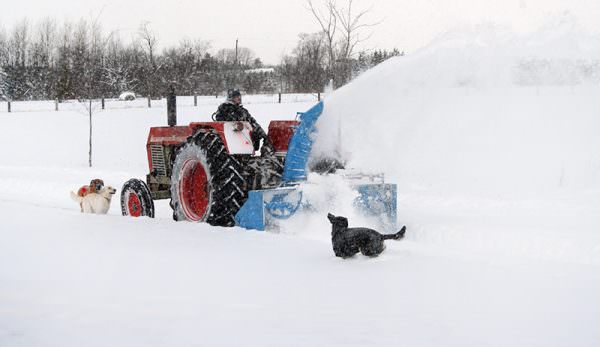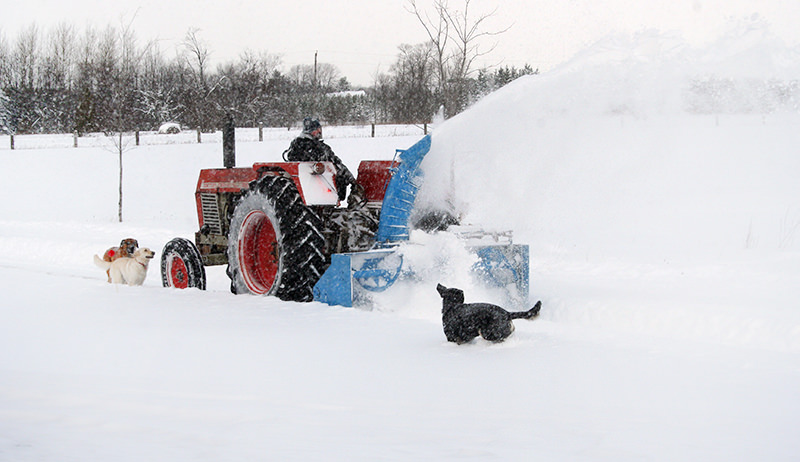
A whirlwind of snow blowing across the field, flurries in the air outside the kitchen window, collected snow on tree branches—snow can certainly be beautiful … until it’s in your way. Before you know it, that pretty midwinter snowfall has added up to several inches of deep powder that inhibit travel and make farm work more difficult.
For farmers in particular, snow removal can be a huge issue. Farm chores must keep on going, regardless of weather or snow depth. Schools and other places of business may have the option of throwing in the towel and calling a snow day, but farmers rarely—if ever—have this option.
Happily, the tools you need are readily available and generally economical. Let’s take a look at some of the tools and machines you might want in your winter arsenal, how you’ll use them and what they’re likely to cost. In no time, we’ll clear those paths to the barns, sheds and garages and help make life easier on you and your livestock. The prices listed are only ballpark numbers to help you get a rough idea; actual prices vary widely depending on manufacturer, exact specifications and region.
Hand Tools
Sure, we all reach for the machines when possible, but there are times when hand tools are preferable. They’re simpler than machinery but still quick and good for small jobs, and they are capable of fine work in areas where a machine might be too imprecise. So before you run out and fire up the snowblower, first consider the following simple man-powered machines.
Snow Shovel

For porches, stairs and some walkways, and clearing out around doors, never underestimate the value of a standard snow shovel. Pusher-style snow shovels can be useful for clearing wide, flat areas where the snow isn’t too deep, such as decks and porches, but they generally aren’t as useful as regular snow shovels for most tasks. Scoop-type shovels also work well, especially when digging through very deep snow. Get a few snow shovels for the house and buildings, and keep one in your vehicle, too. Expect to pay between $20 to $40.
Digging Bar
This tool is a must for late winter work, when snow and ice have become packed and dense around doorways and walkways. Use it to chip, scrape and pry away stubborn patches of snow. Be careful, though: You can accidentally damage concrete with this tool, and don’t forget to always wear safety glasses when using a digging bar. Expect to pay between $30 to $60.
Standard Shovel

Don’t put away your everyday square- and round- point garden shovels just because winter has set in. You’ll still want your round-point shovel for getting into tight corners that your snow shovel can’t reach and also for digging out very dense snow that has been packed and frozen from walking or driving. Keep the square-point shovel handy for getting a sharp, clean scrape on flat areas such as stairs, concrete and around garage doors. Your snow shovel is great for moving bulk amounts of loose snow, but your digging shovels are critical winter tools for the times when you need to actually dig the snow away. Expect to pay around $30.
Machines
For the big jobs of clearing driveways, walkways, parking areas and general farm cleanup, it’s time to break out the machines. It’s a big job, but nothing beats being in control of your own snow removal.
Walk-Behind Snow Blower

This type of snowblower might give you a workout, but don’t underestimate the snow-clearing abilities of these fine machines. Selecting the right horsepower for the size of your job and the amount of snow you expect is critical, as is choosing an ideal width.
Larger machines can be more expensive and perhaps a little more difficult to maneuver but, in general, are well worth it. A snowblower with insufficient horsepower or width will greatly increase your work time, as you’ll have to work very slowly to avoid overwhelming the machine. Go as big as you can afford and handle. An electric starter is another feature to look for, as it’s very useful for starting cold engines. Expect to pay between $500 to $1,500.
Lawn Tractor Snow Blower
Some larger lawn tractors can be fitted with a snowblower attachment, offering more width than a walk-behind blower, as well as the added convenience of requiring less muscle. One disadvantage is that these blowers are typically brand- and model-specific, meaning you may have a more difficult time finding a match for your lawn tractor if you can get one at all. You’ll also have to remove your mower deck each fall to mount the snowblower.
Make sure you get wheel chains and weights for proper traction; those regular tires are not effective in snow! Another optional feature is a lightweight cab to protect you from the elements while you work. Expect to pay between $1,500 to $2,000.
Full-Size Tractor Snow Blower

For the ultimate in snowblowing power, you can also find models to fit on your full-sized tractor. Here you have two options: front-mounted and rear-mounted, with advantages and disadvantages to each. A rear-mounted blower will likely attach to your tractor’s three-point hitch, making it easy to hook up and more compatible with other tractor brands. (This can equate to a high resale value, as the snowblower won’t be brand-specific.) Rear-mounted models tend to be somewhat tougher and more durable and can handle a lot of snow. The main problem with them—and it’s significant—is that you have to drive backwards at all times while blowing snow, which is decidedly annoying. That said, rear-mounted snowblowers can also be significantly cheaper than front-mounted ones.
A front-mounted snowblower is trickier to install, more complicated and likely requires a blower specific to your brand and even model of tractor, not to mention that it also usually requires a mid-mount power take-off (PTO) system. It might or might not be as durable as a rear-mounted blower. But you can blow while driving forward, speeding up the workflow and making it much easier on the driver. Expect to pay between $2,000 to $5,000.
ATV/UTV Snowblower
That handy ATV or UTV that works so hard on your farm can gain some additional versatility with the addition of a snowblower attachment. Because some ATVs or UTVs lack PTO systems—and therefore can’t supply power to an attachment—some snowblowers of this variety come with their own engines that ride on the back hitch of an ATV or sit in the bed of a UTV. The cost of this extra engine, along with the mechanisms required to achieve front snowblower mounting, means that you can expect to pay more for these attachments. Newer models, however, might feature PTO systems, negating the need for an extra engine. Also, your ATV might need a pre-installed winch to attach to the blower. Expect to pay between $5,000 to $7,000.
Snowplow
Of course, we can’t forget plain old snowplows. As great as snowblowers are for certain situations, there’s nothing quite like the deep-down scraping you get with a snowplow. The cheapest and most common variety, the straight plow—as opposed to the V-plow you might see on a more commercial rig—comes in many sizes that can be affixed to your ATV, UTV, tractor and, of course, pickup truck. For regions where heavy snowfall is common, you’ll probably want to go the classic truck route, which will provide you maximum speed, power and comfort. For shorter driveways and paths, you may find a tractor or ATV/UTV very useful and capable of fulfilling all your plowing needs. You might also see these plows advertised as front blades. Expect to pay $1,000 to more than $5,000.
This article originally ran in the January/February 2016 issue of Hobby Farms.




